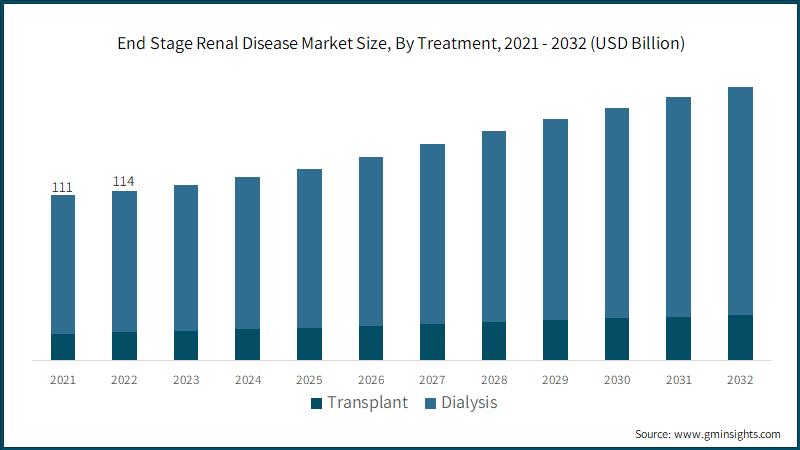Home > Healthcare > Medical Devices > Therapeutic Devices > End Stage Renal Disease Market
End Stage Renal Disease Market Analysis
- Report ID: GMI6256
- Published Date: Jul 2023
- Report Format: PDF
End Stage Renal Disease Market Analysis
Based on treatment, the end stage renal disease market is segmented as transplant and dialysis. The dialysis segment dominated the market accounting over 83% business share in 2022. The increasing demand for dialysis is owing to rising number of people suffering from end stage renal disease. Increasing prevalence of diabetes, hypertension, chronic kidney disease coupled with aging population is anticipated to drive the demand for dialysis across the globe. For instance, according to the International Diabetes Federation data, in 2022, around 783 million people globally were estimated to suffer from diabetes. This prevalent population necessitates the demand for dialysis as chronic kidney disease may lead to end stage renal disease.
Additionally, governments, healthcare organizations, and private providers have invested in expanding dialysis centers and improving infrastructure to ensure that more ESRD patients have access to dialysis treatments. This increased access has contributed to the growing demand for dialysis. Technological advancements in dialysis equipment and techniques have made dialysis treatments more effective, efficient, and convenient. Innovations such as high-flux membranes, improved dialysis machines, and home-based dialysis options have enhanced patient outcomes and comfort, making dialysis a more viable treatment option. These advancements have also contributed to increased demand for dialysis.
Based on diagnosis, the end stage renal disease market is segmented as blood test, urine test, imaging test and others. The blood test segment accounted for around USD 43.7 billion in 2022. Blood tests play a critical role in the diagnosis and monitoring of end stage renal disease. Screening blood tests, such as serum creatinine and estimated glomerular filtration rate (eGFR), help identify individuals with decreased kidney function. Increasing awareness regarding the importance of early detection, individuals are undergoing blood testing to assess their kidney health and identify any signs of kidney dysfunction or ESRD. Blood tests, including serum creatinine, blood urea nitrogen (BUN), and electrolyte panels, are routinely used to monitor kidney function in individuals with known kidney disease or ESRD. Such kidney function tests help assess the progression of kidney disease, monitor treatment effectiveness, and detect any complications that may arise.
Blood tests play a crucial role in the evaluation of potential kidney transplant recipients. These tests help assess the compatibility between the donor and recipient, detect potential infections or diseases that may impact the transplant outcome, and evaluate the overall health status of the recipient before transplantation. The development of more advanced and comprehensive blood tests, coupled with ongoing research and technological advancements, is estimated to play a significant role in improving the accuracy, efficiency, and accessibility of blood-based diagnostics for end stage renal disease.

Based on end-use, the end stage renal disease market is segmented as hospitals, dialysis centers and others. The hospitals segment held a dominant market share and accounted for around USD 55.4 billion in 2022. Hospitals provide a wide range of services including hemodialysis and peritoneal dialysis as well as perform kidney transplantation among patients suffering from end stage renal disease. Hospitals play a central role in diagnosing and managing ESRD patients, particularly in providing specialized care such as dialysis and kidney transplantation. Hospitals often have specialized departments, such as nephrology and urology, with expert healthcare professionals in managing end stage renal disease. These departments are equipped with the necessary infrastructure and technology to diagnose and treat ESRD effectively. Hospitals are incorporated with dialysis units within their premises, offering in-center hemodialysis or home-based dialysis options.
Additionally, hospitals also have dedicated transplant teams comprising surgeons, nephrologists, transplant coordinators, and other healthcare professionals with expertise in kidney transplantation. ESRD patients seek hospitals with established transplant programs to undergo evaluations, transplantation surgeries, and post-transplant care. ESRD often requires multidisciplinary comprehensive care involving various healthcare professionals to collaborate and manage the complexities associated with ESRD. The ability to provide integrated care within a hospital setting enhances patient outcomes and drives the demand for hospital-based end stage renal disease services. Hospitals offer advanced diagnostic facilities, including specialized laboratory testing, imaging techniques, and interventional procedures, to diagnose and manage ESRD.

North America region held a majority share in the end stage renal disease market and was valued at USD 51.1 billion in 2022. This high market share is ascribed to a variety of factors, including the presence of significant industry players, an increase in the number of patients suffering from end stage renal diseases, surging elderly population, among others. Hypertension is one of the major factor influencing the prevalence of end stage renal disease. For instance, according to the American Heart Association data, in 2022, over 122 million adults in America were suffering from hypertension. Additionally, around 15% adults suffering from hypertension were at the risk of kidney failure. This patient population increases the demand of dialysis and kidney transplantation for the diagnosis and treatment of end stage renal disease.
North America has well-developed healthcare systems that provide relatively widespread access to healthcare services. This includes access to specialist nephrology care, dialysis facilities, and kidney transplantation centers, enabling patients to seek timely diagnosis and treatment for ESRD. North America has a robust infrastructure for dialysis services, including in-center hemodialysis and home-based dialysis options such as peritoneal dialysis and home hemodialysis. The demand for dialysis services is increasing as more individuals require continuous renal replacement therapy.

